The Amazonian town putting world cities to shame
 In the Colombian town of Leticia, bustling with market traders and various modes of transport, I purchased a ticket from a small office by the Malecón promenade. After navigating through the wooden houses on stilts, I reached the floating platforms by the Amazon River, where I descended a slippery bank and presented my ticket to a busy attendant distributing life jackets.
In the Colombian town of Leticia, bustling with market traders and various modes of transport, I purchased a ticket from a small office by the Malecón promenade. After navigating through the wooden houses on stilts, I reached the floating platforms by the Amazon River, where I descended a slippery bank and presented my ticket to a busy attendant distributing life jackets.
Confirming my destination to be Puerto Nariño, I boarded a covered motor launch, relieved to settle into a plastic seat near the front and enjoy an unobstructed view of the majestic Amazon River, the world's largest by volume.
Leticia and Puerto Nariño, situated 75km apart along the Amazon's banks, present contrasting atmospheres. While Leticia bustles with activity, Puerto Nariño stands out as a serene haven promoting sustainable living. Unlike its bustling counterpart, Puerto Nariño prohibits motor vehicles, maintaining streets as pristine as those found in Copenhagen. This represents a beacon of hope amid gloomy climate predictions, with indigenous leadership playing a significant role in its success.
Access to Puerto Nariño is exclusively by boat, a captivating journey of approximately two hours from Leticia, flanked by Peru on one side and Colombia on the other. Arriving at the community's modest boat dock where the Amazon and Loretoyaco rivers meet, one quickly realizes they've reached a unique enclave in the jungle, far removed from the ordinary.
Sustainable Living in Puerto Nariño
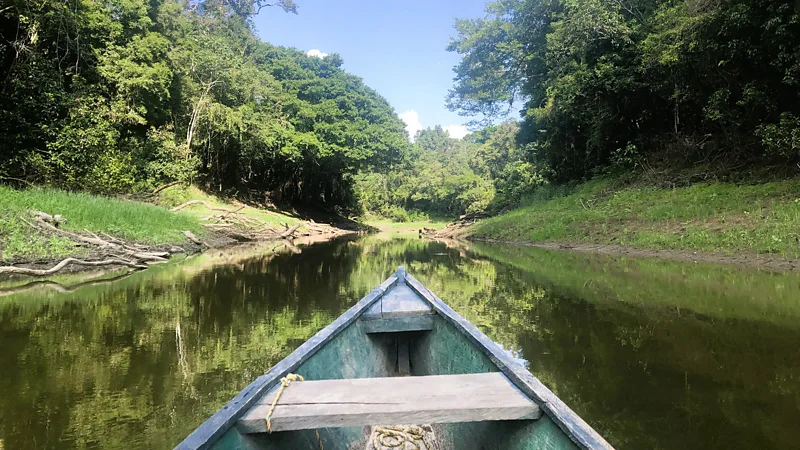 Dubbed "the natural cradle of Colombia," Puerto Nariño sets a hopeful example of coexistence with nature. Recognized as the country's inaugural "sustainable tourist destination" by the Ministry of Commerce, Industry, and Tourism in 2012, it resides amidst endangered rainforests, pivotal in climate change discourse. Its allure draws a growing stream of curious visitors eager to explore the pulse of the planet's vital "lungs" firsthand.
Dubbed "the natural cradle of Colombia," Puerto Nariño sets a hopeful example of coexistence with nature. Recognized as the country's inaugural "sustainable tourist destination" by the Ministry of Commerce, Industry, and Tourism in 2012, it resides amidst endangered rainforests, pivotal in climate change discourse. Its allure draws a growing stream of curious visitors eager to explore the pulse of the planet's vital "lungs" firsthand.
Recent developments in the Colombian Amazon present a nuanced picture. Although deforestation reportedly plummeted by 70% in 2023, a historic drought brought adversity, imperiling wildlife and agricultural yields.
Initial impressions of Puerto Nariño are uplifting. Tidy terracotta pathways, adorned with lush foliage, sprawl out from the riverfront in a meticulously planned layout. Vibrant wooden dwellings adorned with intricate murals and artisanal crafts signify the prominent presence of indigenous communities, comprising roughly 80% of the town's 6,000 inhabitants.
Diverging from the bustling urban scenes of other Colombian locales, Puerto Nariño embraces a vehicle-free ethos. With no roads and only two authorized vehicles—a rubbish-collecting tractor and an emergency ambulance—the town fosters cleanliness and tranquility. Shimmering silver trash receptacles dotting the streets, harmonized with avian melodies, evoke an ambiance of calm, order, and environmental stewardship.
Tourism Initiatives in Puerto Nariño
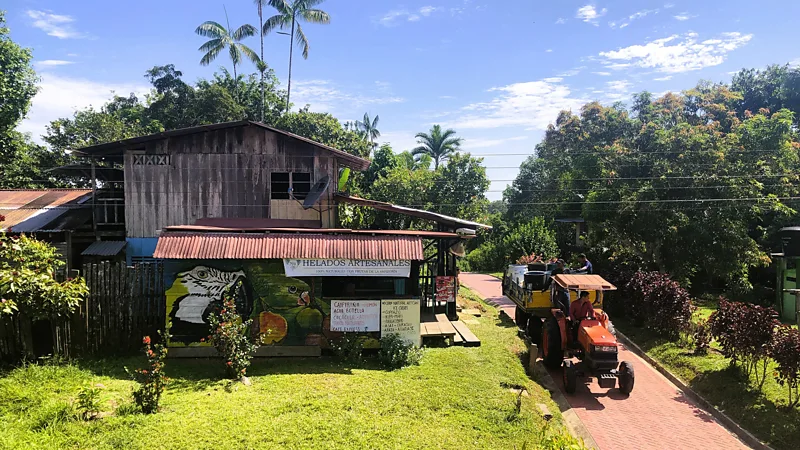 Upon paying a COP$15,000 (£3) entrance fee allocated to town upkeep, I embarked on a discovery stroll through Puerto Nariño. Unlike typical Amazonian villages characterized by muddy pathways and overgrown foliage, this community boasted neatly groomed grass-fronted shops vending vibrant crafts. Surrealistic statues depicting local fauna, including turtles, pink dolphins, and parrots, adorned the surroundings. Amidst the lively scene, a spirited game of five-a-side football unfolded under a vast metal canopy by the river, while industrious locals tended to their tasks with wheelbarrows and brooms, maintaining pristine pathways.
Upon paying a COP$15,000 (£3) entrance fee allocated to town upkeep, I embarked on a discovery stroll through Puerto Nariño. Unlike typical Amazonian villages characterized by muddy pathways and overgrown foliage, this community boasted neatly groomed grass-fronted shops vending vibrant crafts. Surrealistic statues depicting local fauna, including turtles, pink dolphins, and parrots, adorned the surroundings. Amidst the lively scene, a spirited game of five-a-side football unfolded under a vast metal canopy by the river, while industrious locals tended to their tasks with wheelbarrows and brooms, maintaining pristine pathways.
Established in 1961, Puerto Nariño predominantly comprised Indigenous populations residing in separate family malocas (traditional longhouses). Its allure steadily attracted intrepid travelers.
According to Luz Jenny Torres, a leader in sustainable tourism within the municipality, Puerto Nariño's journey as a tourist destination evolved over the years. Initially drawing sporadic visits from small tourist groups in the 1980s and '90s, accommodations were basic wooden hotels. By the early 2000s, a more consistent influx of tourists, including families and university students, was observed. In 2004, then-mayor Edilberto Suárez Pinto spearheaded efforts to enhance urban aesthetics, bolster tourism in Indigenous communities, and manage tourist infrastructure, laying the groundwork for sustainability.
In 2007, Torres proposed to the mayor that Puerto Nariño serve as a pioneering model for sustainable tourism nationwide. This proposal materialized into a comprehensive plan, positioning Puerto Nariño as a shining example of grassroots green tourism in a country striving for renewal following years of conflict.
Indigenous Environmental Practices and Sustainable Agriculture in Puerto Nariño
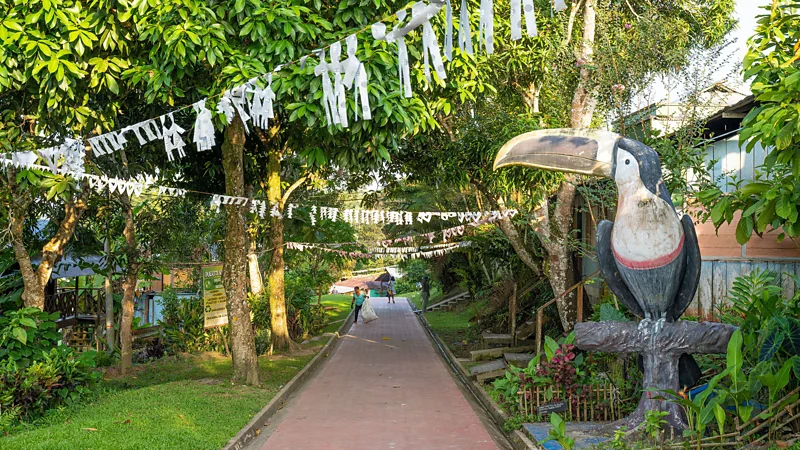 The Indigenous communities of Puerto Nariño have long upheld environmental stewardship, rooted in a profound connection with their natural surroundings. Practicing sustainable agriculture since pre-Columbian times, farming revolves around chagras, small plots of land cleared during the dry season and rotated to maintain soil fertility.
The Indigenous communities of Puerto Nariño have long upheld environmental stewardship, rooted in a profound connection with their natural surroundings. Practicing sustainable agriculture since pre-Columbian times, farming revolves around chagras, small plots of land cleared during the dry season and rotated to maintain soil fertility.
Local families cultivate sufficient crops on their chagras to meet their needs, with surplus produce sold at the daily waterfront market. The market showcases a variety of fresh produce, including cassava, chillies, onions, squash, chicory, bananas, papayas, and mangos.
Restaurants in Puerto Nariño, including upscale establishments like Waira Selva, primarily source their ingredients from the local market. Amazonian fish, a staple protein, are prominently displayed, with the surrounding rivers boasting a diverse array of species such as catfish, piranhas, and pirarucu, one of the world's largest freshwater fish.
Local fishers also play a vital role as environmental stewards, collaborating with the Natütama foundation, established in 2005. Natütama operates an interpretation center staffed by Indigenous guides, monitoring river wildlife. In 2023, fishers recorded numerous pink dolphin and manatee sightings, crucial for conservation efforts and tourism. Guided wildlife excursions, led by Indigenous guides in peque-peque motorboats, offer visitors opportunities to observe pink dolphins, sloths, and turtles in nearby Lake Tarapoto, a Ramsar wetlands site since 2018.
Community-Led Conservation and Environmental Education in Puerto Nariño
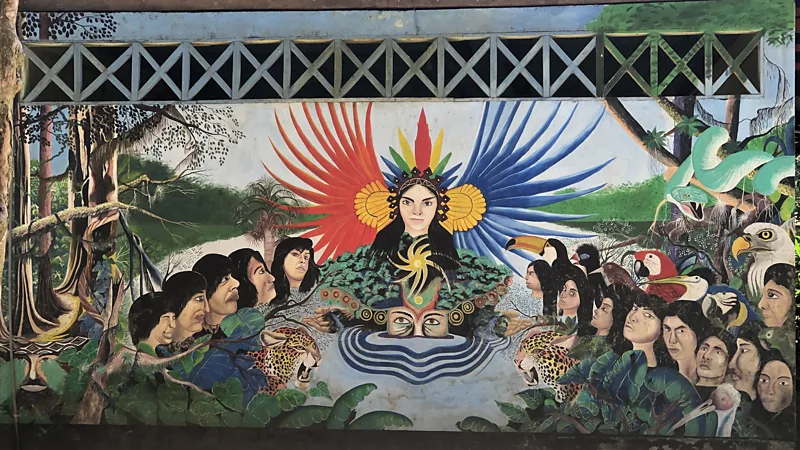 Natütama, besides monitoring endangered species, plays a pivotal role in educating children about Amazonian ecology and conducting environmental workshops in local colleges and Indigenous communities. Marelvi Laureano, an education coordinator, emphasizes the importance of intergenerational understanding, particularly highlighting the cultural wisdom of grandparents in fostering community respect and care.
Natütama, besides monitoring endangered species, plays a pivotal role in educating children about Amazonian ecology and conducting environmental workshops in local colleges and Indigenous communities. Marelvi Laureano, an education coordinator, emphasizes the importance of intergenerational understanding, particularly highlighting the cultural wisdom of grandparents in fostering community respect and care.
The interpretation center serves as both an environmental hub and educational resource, showcasing exhibits that illustrate the region's distinct wet and dry seasons. Visitors learn about local ecosystems, flora, fauna, and their natural interconnections. Additionally, travelers can immerse themselves in Indigenous culture, participating in dances, sampling traditional food, and hearing myths and legends, all while gaining insight into community environmental stewardship efforts.
A notable aspect of Puerto Nariño's conservation endeavors is their grassroots approach, with Indigenous participation at the forefront through organizations like ATICOYA, ensuring local leadership in all conservation initiatives.
After a visit to Natütama, I embarked on a guided boat excursion to Lake Tarapoto, where I had the unique opportunity to swim (despite the presence of piranhas). The day concluded with a climb up Puerto Nariño's iconic wooden tower, offering a breathtaking panoramic vista of the river and surrounding jungle.
Sustainable Lifestyle and Tranquil Nights in Puerto Nariño
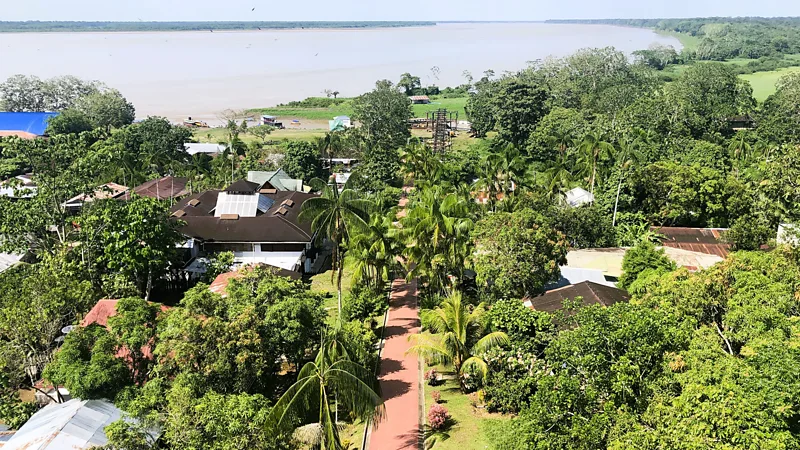 At the base of the tower, vendors offer homemade ice cream in various tropical flavors. Opting for camu camu, derived from a cherry-like fruit abundant in vitamin C, I wandered around town, observing its innovative eco-initiatives: recycled plastic bottle plant pots, meticulously maintained gardens, and a water filtration facility serving as a community refill station.
At the base of the tower, vendors offer homemade ice cream in various tropical flavors. Opting for camu camu, derived from a cherry-like fruit abundant in vitamin C, I wandered around town, observing its innovative eco-initiatives: recycled plastic bottle plant pots, meticulously maintained gardens, and a water filtration facility serving as a community refill station.
A favorite spot of mine was a quaint restaurant with a terrace overlooking the five-a-side football court, where I savored grilled fish amidst the lively cheers of players, before retiring to my humble cabin accommodation.
Paragraph:
Nighttime in Puerto Nariño, devoid of traffic, exuded a soothing ambiance. Fueled by community-driven initiatives, the town boasts a unique blend of jungle serenity and Scandinavian-inspired order amid the vast Amazon rainforest. While it may not offer a definitive solution to the complex environmental challenges facing the region, Puerto Nariño's efforts serve as an encouraging step in the right direction.




























